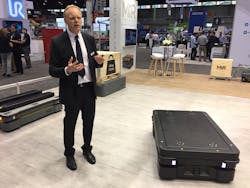At this week’s Automate show in Chicago, it was interesting to see just how many autonomous mobile robots (AMRs) were running around the booths—all shapes and sizes, showing off any number of tasking capabilities. One of the biggest robots finding its own way around the booth space was a new AMR from Mobile Industrial Robots (MiR), which has launched a model capable of twice the payload of its previous models.
The MiR1000 can automatically pick up, transport and deliver pallets and other heavy loads up to 1,000 kg (2,200 lbs) through dynamic environments. Like its predecessor, the MiR500, the MiR1000 is a collaborative, safe and flexible alternative to forklifts on the factory floor.
MiR’s AMRs (which also include the MiR100 and MiR200) are already installed in more than 45 countries at companies such as Airbus, Flex, Honeywell, Toyota, Visteon and Hitachi. MiR was hearing from some customers, however, that the payload wasn’t quite enough, particularly in aerospace and automotive industries.
“With the MiR1000, we are once again extending the possibilities for automating internal logistics, especially for those who want to transport very large materials without reconfiguring their infrastructure,” said Thomas Visti, MiR’s CEO. “Manufacturers today must deal with ever-changing customer demands, which means they need flexible and easily adaptable production facilities. Conventional logistics solutions like forklifts and conveyor belts and even traditional automated guided vehicles [AGVs] haven’t been able to support this type of production.”
MiR’s customers are typically big multinational companies that have experience with automation, commented Ed Mullen, MiR’s vice president of sales for the Americas. “They’re looking for a unique way to add efficiency to their operations,” he said, adding that MiR’s AMRs give them that flexibility and the ability to take complete ownership.
Though big companies are typically the first movers, Visti said, he expects that within a few years, small and midsize companies will be adopting the technology as well.
The MiR1000 is even easier to set up and introduce than its predecessors, commented Niels Jul Jacobsen, founder and CSO of MiR. It’s also even safer. It has two cameras, giving it the same vision as humans, as well as a new near-field sensor, noted Niels Jul Jacobsen, founder and CSO of MiR. The latest robot has gone from four safety features to eight, prepared to operate within new ISO standards that MiR is helping to develop.
“They’re much more safe to operate around. And they should be. These are much more dangerous vehicles,” Jacobsen said, commenting not only on the size of the robot itself but the 1,000 kg payload it could be carrying.
The MiR1000 has two flexible pallet lifts for the two most commonly used types of pallets: the EU pallet and the 40 x 48 inch pallet common in the U.S. The AMRs can also easily integrate different top modules such as pallet lifts, conveyors, a robot arm or other options to support a wide range of applications.
As an example, ROEQ was showing at its booth its latest launch, the TR1000, a top roller that fits on top of the MiR1000. ROEQ puts a lot of focus on keeping the equipment safe, commented Peder Grejsen, technical sales manager for the fellow Danish company, taking care not to negate the safety features built into the AMR itself.
“We’re focused on keeping the technology collaborative,” Grejsen said. To that end, they’ve avoided having metal sticking up (a common way to keep the load from rolling off) and eliminating potential pinch points in the roller design.
AI-based navigation
Also helping to keep the AMRs safer and more functional on the factory floor, MiR has released artificial intelligence (AI) capabilities across its entire AMR fleet. AI capabilities incorporated into the robots’ software combines with strategically placed cameras that function as an extended set of robot sensors. This provides optimized route planning and driving behavior for the AMR navigation.
The new launch, called MiR AI Camera, enables the robots to detect and recognize different moving obstacles and react accordingly. For example, the robots will continue driving as usual if they detect a person but will park if they detect an AGV so that the AGV can drive by. The logic there is that the person is capable of walking around the robot. The robot can also predict blocked areas or highly trafficked areas in advance and reroute instead of wasting time entering the blocked area and then rerouting.
MiR has been working on AI for the past two years, according to Jacobsen, who noted that the technology was first developed for a hospital in Denmark.
Though the number of cameras in any given facility could vary considerably, they are useful for any areas of the plant that are known traffic concerns, noted Josh Cloer, MiR’s sales director for the Eastern U.S. This avoids situations today in which two robots each sense the other blocking its way and consequently both sit and look at each other, neither of them moving.
This could be particularly useful in automotive production, Cloer noted, where tight areas and forklift loading have a tendency to stop all traffic. Automotive manufacturers and suppliers alike—Cloer mentioned Toyota and Faurecia—are already MiR customers. “This is an industry that knows it can utilize this technology,” he said.
Warehouses and logistics operations will certainly understand the value of AMRs, Cloer said, adding that he expects semiconductor and electronics industries, as well as food and beverage, to be good candidates going forward.
A side note
Interestingly, MiR was bought in April last year by Teradyne, a U.S.-based supplier of automated test equipment. Teradyne has been snatching up several players in the robotics space—also acquiring Universal Robots, a collaborative robot manufacturer, in 2015; and Energid Technologies, which has developed a software platform for dynamic motion control of robots, early last year.
More to come on the latest developments from both Universal Robots and Energid Technologies.

